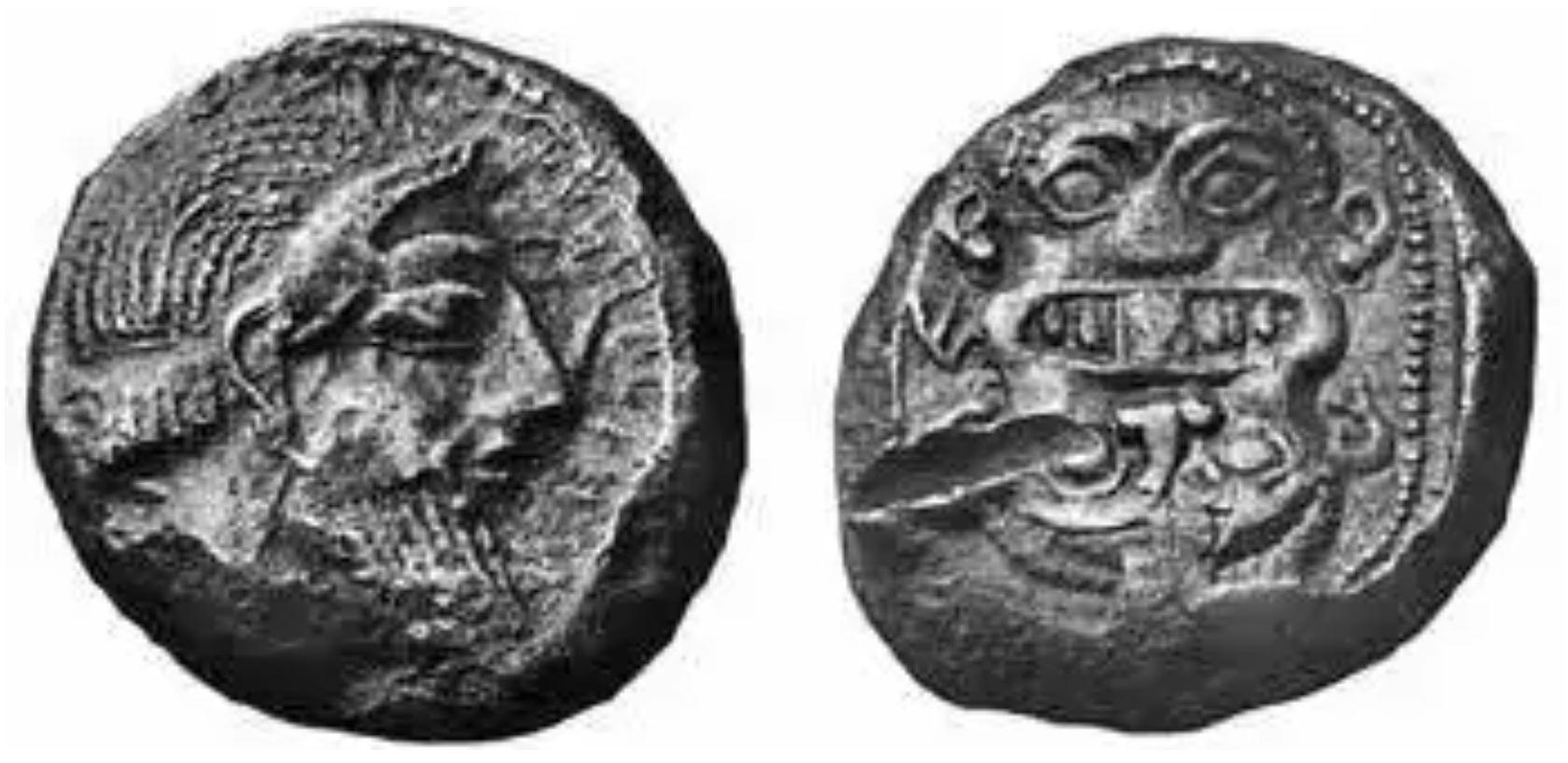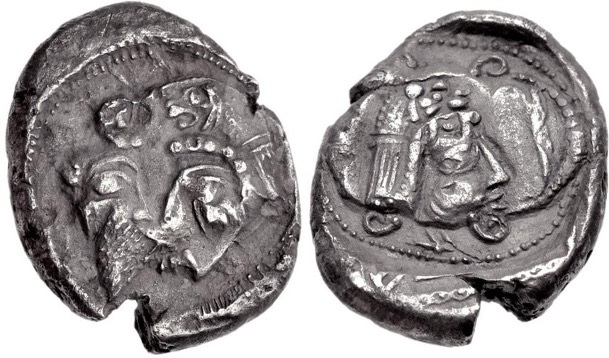375 BCE - 332 BCE | "S"( Aramaic shin)
Overstruck variety
Gitler_-_Tal_2016, _p._14, _fig._4..png
[2]
|
|
Sale(s)Sale(s) ᵖ:
|
Classical Numismatic Group, MBS 84, 05 May 2010, 708.
|
|
|
|
Description
| ObverseInscription or printing placed on the obverse.:
|
Two confronted male heads, the left bearded, each wearing headdress in form of lion forepart.
|
ReverseInscription or printing placed on the reverse.:
|
"S"( Aramaic shin) Bearded head right, wearing headdress in form of lion forepart.
|
Mint and issuing power
| MintIdentifies the place of manufacture or issue of a numismatic object.:
|
Samaria
|
Ancient regionAncient region.
|
Samaria
|
Modern countryModern country: Palestine
|
AuthorityIdentifies the issuing power. The authority can be "pretended" when the name or the portrait of X is on the coin but he/she was not the issuing power. It can also be "uncertain" when there is no mention of X on the coin but he/she was the issuing power according to the historical sources:
|
|
Chronology
| FromIdentifies the initial date in a range assigned in a numismatic context. 375 BCE toIdentifies the final date in a range assigned in a numismatic context.. 332 BCE
|
Classical 480-323 BC  periodTime period of the numismatic object. periodTime period of the numismatic object.
|
Physical description
MetalThe physical material (usually metal) from which an object is made.: Silver 
|
WeightWeight of the numismatic object (in grams). in grams: 3.323.32 g <br />3,320 mg <br />
|
DenominationTerm indicating the value of a numismatic object. Examples: tetradrachm, chalkous, denarius.: drachma 
|
AxisDescribes the directional relationship between the obverse and reverse of a numismatic object.: 1212 mm <br />1.2 cm <br />
|
| DiameterDescribes diameter of an object (in mm).: 1414 mm <br />1.4 cm <br />
|
StandardStandard.: Samarian
|
References
Description
| ObverseInscription or printing placed on the obverse.:
|
Male head right, bearded.
|
ReverseInscription or printing placed on the reverse.:
|
Double Bes head joined at the mouth.
|
Mint and issuing power
| MintIdentifies the place of manufacture or issue of a numismatic object. ᵖ:
|
|
Ancient regionAncient region. ᵖ
|
Philistia
|
Modern countryModern country:
|
AuthorityIdentifies the authority in whose name (explicitly or implicitly) a numismatic object was issued. ᵖ:
|
|
Chronology
| FromIdentifies the initial date in a range assigned in a numismatic context. 450 BCE toIdentifies the final date in a range assigned in a numismatic context.. 331 BCE
|
Classical 480-323 BC  periodTime period of the numismatic object. periodTime period of the numismatic object.
|
Physical description
| DenominationTerm indicating the value of a numismatic object. Examples: tetradrachm, chalkous, denarius. ᵖ:
|
drachma 
|
|
|
References
| Frequency of overstrikesFrequency of overstrikes:
|
|
Level of confidenceLevel of confidence of the identification:
|
|
| RemarksRemarks:
|
"Second, and most important, is the fact that this coin is clearly struck over a Philistian drachm, which helps to establish a relative chronological point for both series."
|
References
- ^ Hoover, Oliver D. (2010), The Handbook of Greek Coinage Series. 10. handbook of coins of the Southern Levant : Phoenicia, southern Koile Syria (including Judaea), and Arabia, Lancaster-London, lxxix, 201 p.
- ^ Gitler, Haim - Tal, Oren (2006), The Coinage of Philistia of the Fifth and Fourth Centuries BC. A Study of the Earliest Coins of Palestine, Collezioni Numismatiche 6, Milan
- ^ Gitler, Haim - Tal, Oren (2016), "Reclassifying Persian-Period Philistian Coins: Some New Identifications", Israel Numismatic Research, 11, p. 11-22.

